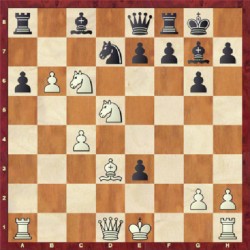This weekend, chess lovers will witness the beginning of the popular Tata Steel Chess Tournament in Wijk aan Zee, Netherlands. This, the 77th edition of the tournament is set to attract the world’s finest chess grandmasters.
In 1975, the organizers inaugurated a prize for the most spectacular game of the tournament. They expected breathtaking encounters, griping contests, some glamour and some charm. In essence, the game had to be a delightful one. That inaugural prize was won by grandmaster Lubomir Kavalek, chess columnist, for his game against the Hungarian grandmaster, Lajos Portisch. Other winners of the prize have included world champions Garry Kasparov, Magnus Carlsen and Vishy Anand.
 Kasparov created his indelible masterpiece which the world dubbed his ‘Immortal’ game against Veselin Topalov in 1999. The Washington Post referred to Carlsen as the ‘Mozart of Chess’ when he won the brilliancy prize in 2004 at the age of 13. When Anand collected the coveted prize in 2013, the press reported that the game reminded one of the late stylish Polish grandmaster, Akiba Rubinstein.
Kasparov created his indelible masterpiece which the world dubbed his ‘Immortal’ game against Veselin Topalov in 1999. The Washington Post referred to Carlsen as the ‘Mozart of Chess’ when he won the brilliancy prize in 2004 at the age of 13. When Anand collected the coveted prize in 2013, the press reported that the game reminded one of the late stylish Polish grandmaster, Akiba Rubinstein.
On the eve of Wijk aan Zee, therefore, Kavalek recalls the ‘spectacular’ 40-year-old game and chose to annotate it. The comments for the game are his, unless otherwise specified.
[White “Lajos Portisch”]
[Black “Lubomir Kavalek”]
 1.d4 Nf6 2.c4 g6 3.Nc3 Bg7 4.e4 d6 5.f3 c6 6.Be3 a6 7.Bd3 b5
1.d4 Nf6 2.c4 g6 3.Nc3 Bg7 4.e4 d6 5.f3 c6 6.Be3 a6 7.Bd3 b5
8.e5 Nfd7 9.f4 O-O 10.Nf3 Nb6 11.b3 N8d7 12.a4 bxc4 13.bxc4 c5
14.a5 cxd4 15.Nxd4 dxe5 16.Nc6 Qe8 17.axb6 exf4 18.Nd5 fxe3
19.Nc7 Bc3+ 20.Kf1 Bb7 21.Nxe8 Bxc6 22.Nc7 Rad8 23.Rc1 Bd2
24.Nd5 Bxd5 25.cxd5 Nxb6 26.Rc5 Nxd5 27.g3 Rd6 28.Kg2 Rfd8
29.Rxd5 Rxd5 30.Bc4 Rf5 31.Qb3 Rf2+ 32.Kh3 Rd6 33.Qb8+ Kg7
34.Qa7 g5 35.Qxe7 g4 36.Kxg4 Rg6+ 37.Kh3 Rh6+ 38.Kg4 Rg6+1/2-1/2.
After move 13: The incredible journey begins with a knight sacrifice. Black lights up the fire with the central undermining, ignoring the material loss. My decision to make this move was a matter of temperament and curiosity. First, I dislike to back off in chess; secondly, I was curious to see what would have happened, since at this point it was hard to calculate all the consequences. From time to time, one may have such an irresponsible approach. Hence the piece sacrifice. It helps that White did not castle. He will be busy with the central skirmish. The safer 13…a5 would cut Black’s risks considerably, compared with the game, but white would still be better after 14.c5.
Jan Timman wrote: “If we look at the move 13…c5 carefully we must conclude that it is a mistake, but in practice it is hard to judge it that way. Yet, I believe that players like Ulf Andersson or Tigran Petrosian would prefer 13…Rb8 14.a5 Na8 even though this means having to defend on the first three ranks. Black must not be afraid to play his knight on a8.”
18…fxe3‼ During the game I considered the pawn to be very strong, as it ties up the white position to some extent. It is the key to the Queen sacrifice. Portisch told me after the game that he did not calculate the consequences of the sacrifice but just played to win the queen. Timman pointed out that “White’s dark bishop is a vital piece in the Saemisch variation of the King’s Indian Defence.” 19.Nc7 Bc3+! The point of the whole sacrifice, for now white’s King Rook will not be able to get into play easily. Simple counting shows black having only a bishop for the queen, but it would take white a long time to consolidate on all fronts. That was encouraging. 20.Kf1. 20…Bb7 21.Nxe8 Bxc6. Naturally, Timman writes, black steals the best placed knight. 22.Nc7 Rad8 black threatens to utilize the pin on the d-file with 23…Nc5, forcing white to react quickly. Act Four: Huddle on the d-file. At that time, the young Russian master, Mark Dvoretsky wrote: “A fascinating position! White has a great material advantage (Queen for Bishop), but black pieces are active and white’s rook on h1 is not playing. In a joint analysis after the game, neither player found a clear way for white to realize his material advantage; moreover, after a slight inaccuracy white is in danger of falling under a strong attack.” Dvoretsky dominated the B Group in Wijk aan Zee. He was still in his playing days before becoming a chess teacher. 23.Rc1 Perhaps the critical point in the game.
After move 25. Nxb6 : “Of course, black does not have enough material compensation for the queen,” Soltis describes this moment, “But he has practical compensation: The position remains complex, there is no obvious way for white to consolidate – and the clock is ticking.”
The game ended in a draw. It was included in Andrew Soltis’s book The 100 Best Games of the 20th Century, Ranked.
After: 18…fxe3 [DIAGRAM]




